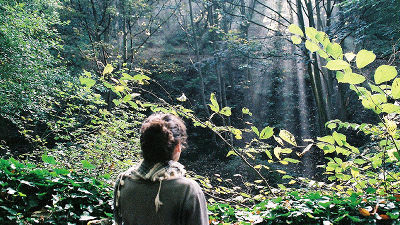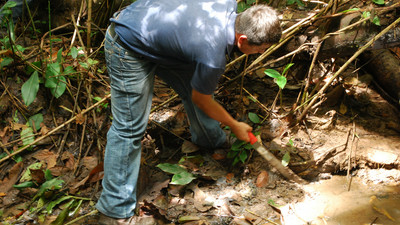What is going on in the no-entry zone of the Chernobyl nuclear power plant accident and what might happen in Fukushima

ByTimm Suess
The accident at the Chernobyl nuclear power plant accident occurred in 1986, as well as the residents around the nuclear power plant, greatly damaged animals and plants in the surrounding area due to radiation exposure. However, the damage caused by radiation is not limited to that, and serious damage has been caused also to small creatures such as insects and microorganisms, and it seems that this has become a problem now that it has traveled around 28 years since the accident took place.
Forests Around Chernobyl Are not Decaying Properly | Science | Smithsonian
http://www.smithsonianmag.com/science-nature/forests-around-chernobyl-arent-decaying-properly-180950075/?no-ist

Twenty-eight years have elapsed since the accident occurred at Chernobyl Nuclear Power plant in 2014, but the impact of this accident is still felt near the accident occurrence area. The area around this accident occurrence area is called a no-entry zone, commonly known as "zone"Some peopleEven now, people do not live, but changes in flora and fauna existing in this zone tell the horror of nuclear accident.
For example, the birds inhabiting the zone are obviously smaller in brain size than the birds living in other areas, the growth rates of the trees around the zone are obviously slow, spiders and bees, The number of insects such as butterflies and grasshoppers is decreasing, etc. There is a big difference in the ecology of animals and plants between the zone and the area with low radiation dose.
Also, as the radiation dose is still at a dangerous level of the wild boar captured in Germany far from Chernobyl, the impact of nuclear accident will not stop only around the point of accident occurrence.

However, there seems to be a bigger problem in the environment around the zone,OecologiaAccording to the latest research published in the literature, it is said that organisms with the role of "decomposing organic matter (the role of returning organic matter to soil)" in nature such as insects and microorganisms are killed by radiation It is that.
Mr. Timothy Mousseau of South Carolina University who is the leading examiner of the impact of nuclear accident, who created this report, and his research team started investigating the zone surroundings since 1991. While investigating the zone surroundings, the forest of a pine tree that changed its color into a reddish color by taking in the radioactive substance generated in the nuclear accident "Red Forest"I notice that the trees that were supposed to have died even if 15 to 20 years passed since the nuclear accident occurred were not corroded.
Normally, in 10 years since trees collapse, most of them corrode and become like sawdust, but the dead trees of the red forest remain intact even after several decades The research team confirmed that the dead leaves are increasing year by year on the ground of this red forest. From this, Mousseau's research team began thinking, as something has happened to small creatures that will degrade organic matter such as insects and microorganisms living in the red forest, I decided to do some field experiments.

ByRoman Harak
In field experiments, measure the thickness of fallen leaves accumulated on the ground at several different places in the zone. As a result, the deeper leaves are thicker in areas with higher radiation dose in the zone, depending on the location, it turns out that there are two or three times the layer thicknesses in other places.
However, this survey alone was insufficient to say, "The activities of creatures that degrade organic matter by radiation are slowing down, that is, the number of microorganisms is decreasing", so I decided to prove this I will do experiments that will.

ByStahlmandesign
In the experiment conducted by the research team, we first collect multiple fallen leaves collected from trees such as oak trees, autumn leaves, birch marks, pine trees from regions with low radiation doses other than zones, and check for insects. And packaged fallen leaves are packed in a mesh bag, half of the bag is covered with pantyhose so that insects do not enter from the outside, and a total of 600 bags are installed everywhere in the zone, that place We exposed to radiation according to the contamination degree of the place.
Normally, as long as a year, leaves in the bag are sufficient for microorganisms and insects to decompose. I covered the pantyhose to clarify whether it is insects in the zone or microorganisms to break down the contents of the bag. If the leaves in the pantyhose are corroded, the insects that can not enter the pantyhose are not the perpetrators who have corroded the leaves, and those of sizes that can not be discerned by the naked eye like microorganisms are the perpetrators .
As a result of this experiment, in the area without radiation, 70 to 90% of the leaves were disassembled and disappeared from the bag. However, about 60% of the bags placed in the area where the radiation was present remained the original weight, and the leaves packed in the bag never disappeared.

Comparing the bag with the pantyhose and the bag not so, you can see how much the insect played the role of decomposing the leaves, but according to the experimental results it was working with bigger decomposition of organic matter He said that he was a microorganism.
In addition, in this field experiment, we set up bags filled with leaves in various places, but this will ascertain how external factors such as temperature, humidity, tree type and soil are related to leaf decomposition I was able to do it.
"The main point of our research results is that the influence of radiation reduced the number of microorganisms and the decomposition of the leaf layer was suppressed," Mousseau said. Furthermore, he said "suppression of decomposition of leaves means that nutrients have not been efficiently returned to the soil, and the growth of trees near the Chernobyl nuclear plant is not slowed down due to the nutritional deficiency of this soil I also point out.

ByJohann Dréo
Other studies point out that the zone of Chernobyl is increasing the risk of fire. This is due to the decline of insects occurring in the zone and the slowing down of decomposition activity of microorganisms, 28 years of fallen leaves from the accident have accumulated in the puddle, and this fallen leaves are just good fuel when a forest fire occurs It is because it becomes.
In addition, Mousseau points out that if a fire happens radiation will be scattered around again, radiation may spread out of the zone, "Mr. Mousseau said," A large fire will occur in the coming years The probability of occurrence within within certainty is definitely increasing. " However, a clear way to solve this problem has not been found at the moment.

ByRyan Howley
In addition, Mousseau and the research team cooperated with the Japanese research team and plan to investigate whether the number of microorganisms is decreasing even near the accident site of the Fukushima Nuclear Power Damage Accident. In Fukushima, the same situation as Chernobyl It is suggesting the possibility of occurrence.

ByTimm Suess
Related Posts:
in Science, Posted by logu_ii







